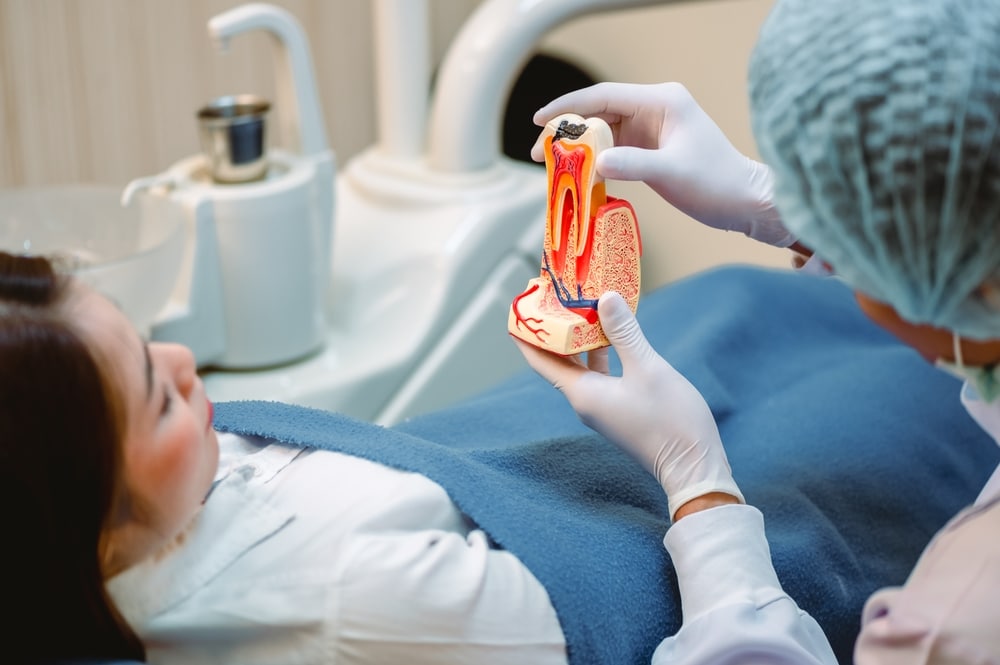At Sacramento Surgical Arts, we understand that endodontic procedures can be intimidating, which can lead to confusion and stress. Our objective is to provide clear and comprehensive information about these services, underscoring our commitment to your oral health and well-being.
With a team of skilled and compassionate professionals at our clinic in California, we are well-equipped to prioritize your comfort and safety throughout every step of your treatment. If you are in need of an apicoectomy, rest assured that we will ensure you are fully prepared and all questions are answered. Read below to learn more!
What Is An Apicoectomy?
An apicoectomy, also known as a root-end resection, is a common procedure used to save damaged teeth. In this surgical procedure, an incision is made in the gum tissue in order to expose the bone and the nearby inflamed tissue.
Our team will remove the damaged tissue along with the end of the root tip. We will then place a root-end filling to prevent reinfection of the root. The procedure necessitates only a few sutures, with natural healing typically taking a few months around the bone. After complete recovery, patients can anticipate restored functionality and the ability to chew without experiencing any discomfort.


When Is Endodontic Surgery Necessary?
A root canal is usually sufficient to save teeth with injured pulp due to extraction. However, sometimes a root canal will not be sufficient to heal the tooth. In this case, your endodontist will recommend surgery. Endodontic surgery can be used to find fractures or hidden canals that often don’t appear on x-rays but are still causing pain in the tooth. This procedure may also treat other damaged root surfaces or the surrounding jawbone.
You will likely have some discomfort and swelling following the apicoectomy. As with any oral surgery, minor swelling and discomfort are normal. To alleviate any discomfort, your dentist will likely prescribe an appropriate pain medication to be taken after having oral and maxillofacial surgery. These medications are habit-forming and need to be taken with extreme caution.
What Is A Root, And What Is A Root Canal?
To understand root canal therapy, it is helpful to know a little about the anatomy of a tooth. The pulp is the soft tissue inside the tooth that contains blood vessels and nerves. It extends from the crown of the tooth to the tip of the root. This pulp is important for tooth development and nourishment.
If the pulp becomes infected or inflamed, it can cause a great deal of pain. In some cases, the infection can progress and spread to the bone surrounding the tooth. If this occurs, the tooth may need to be removed.
Every tooth has a portion that you can see called the crown, and every tooth has a portion that holds the tooth in the bone called a root. In order to generate bite forces to chew, the roots have to be healthy. This must be the case not only from the outside but also from the inside. Depending on how much bite force is needed determines how many roots a tooth may have, or the diameter could be larger as well. In other words, the canine tooth has a long and wide root, while most molars generally have three roots in the upper jaw and two roots in the lower jaw.
Root canal therapy is used to treat infection or inflammation of the pulp inside the tooth’s root canal system. The goal of root canal therapy is to preserve the natural tooth. During treatment, the infected or inflamed pulp is removed, and the inside of the tooth is cleaned and sealed. Without treatment, the infection can progress and cause pain, swelling, and even tooth loss.


What Happens During The Root Canal?
The inside of a root contains a canal that can branch into multiple canals. Below, we break down each of the important steps involved in the root canal.
- In each canal, there are blood vessels and nerves. When an infection reaches the root either through a cavity or through a gum (periodontal) infection, it will irritate the nerve causing pain.
- Depending on how severe the infection is, either the cavity can be filled, or you will be referred to an endodontist (root specialist) who will perform a root canal treatment.
- A root canal treatment generally entails the removal of the blood vessel and nerve through the crown of a tooth by creating a small hole in the crown.
- Once the blood vessel and nerve are removed, then a special filling material called gutta-percha is placed, therefore completing a root canal.
- Afterward, the endodontist may send you back to your general dentist for a new crown or new permanent filling.
What Might Cause Someone To Need An Apicoectomy?
Once a root canal has been completed, sometimes an infection may persist or recur. This is because, at the tip of the root, which is called the apex, the main canal breaks apart into multiple smaller canals that can only be seen with a microscope. These canals are similar to the roots of a tree. The endodontist cannot get into these canals. Therefore, if there are bacteria in them, the root and surrounding bone can get re-infected. This causes pain, swelling, and even the appearance of pus.

How Is Apicoectomy Surgery Performed?
In order to get rid of this infection, the apex (tip) of the root has to be cut out, removed, and the surrounding bone cleaned. Then, the surgeon places a special plug into the main root canal to seal it. This process is called an apicoectomy and usually takes about 30–60 minutes.
Schedule your appointment for apicoectomy treatment with an oral surgeon in California. You can contact us today!
